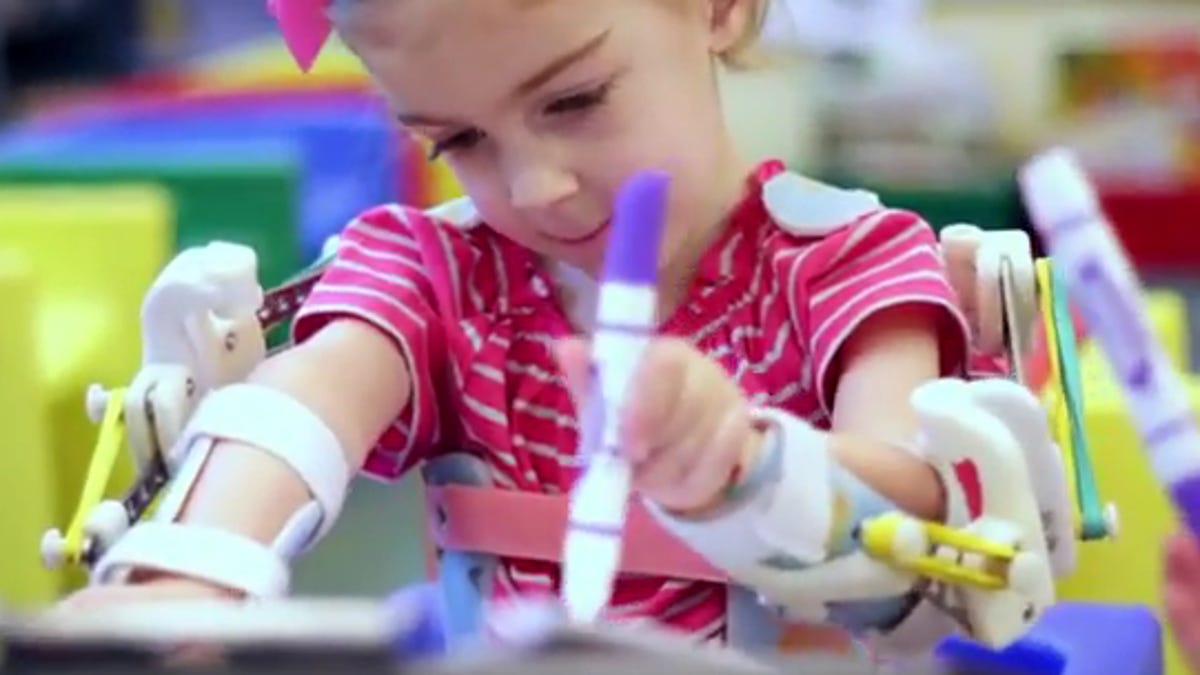3D-printed 'magic arms' give little girl new reach
Customized 3D-printed appendages let Emma Lavelle, and other kids with limited upper-body movement, play alongside their friends with new freedom.

Thanks to 3D-printed plastic appendages, 4.5-year-old Emma Lavelle now plays with blocks.
Born with a rare neuromuscular condition called Arthrogryposis Multiplex Congenita that causes contracted joints and muscle weakness, Emma has almost nonexistent biceps that cannot move against gravity. Her "magic arms," as she has dubbed them, change that.
The plastic appendages attach to a Wilmington Robotic Exoskeleton (WREX) developed at the Center for Orthopedics Research and Development at Delaware's Nemours/Alfred I. duPont Hospital for Children. The WREX is a modular body-powered upper-limb orthosis generally mounted to a wheelchair.
"The existing WREX is all metal parts and is kind of big," Tariq Rahman, a mechanical engineer and head of pediatric engineering and research at Nemours, explains in the video below. "Emma was too small for that, so it required something light and small that would attach to her body that would go with her."
That something comes in the form of a durable little custom body jacket and lightweight 3D-printed plastic appendages. The limbs sport resistance bands on the upper arms and forearms, along with hinged joints that provide a sense of flotation that assists in voluntary movement and allow Emma to move her own arms in space.
While the WREX has been a commercial product sold by JAECO Orthopedics for around seven years, Emma was the first to wear one augmented with 3D-printed parts. Rahman, research design engineer Whitney Sample, and team printed Emma's setup from a Stratasys Dimension 3D printer they already had at the office, and have since printed similar contraptions for about 15 kids with similar upper-body limitations.
Emma -- who was born with her legs up by her ears and her shoulders internally rotated -- spent much of her first two years in casts or undergoing surgery. Though she has been wearing her 3D-printed "magic arms" for three years now, Stratasys only recently released the below video telling her story.
"Without the 3D printer, we would not be in a position we're in with these younger kids, making them a WREX device that can go with them," Rahman says, adding in an interview with CNET that "3D printing is great because we can make these in a couple of days. With a metal one, machining takes longer."
Emma outgrew her first WREX and is now on her second. She wears her exoskeleton not only in occupational therapy, but at home and every day in school. "She does her schoolwork, she writes, of course she plays, and it's a way to socially interact with her peers," Rahman says.
A motorized version of the WREX is currently in the works.
Stay tuned for more stories on medical augmentation as part of an upcoming Crave special package.

